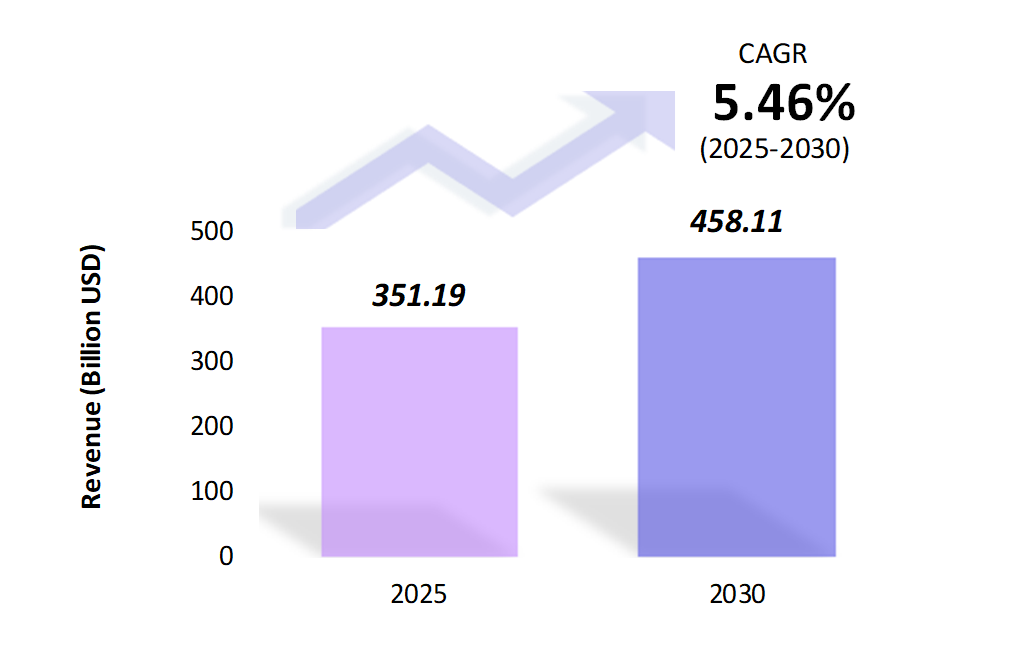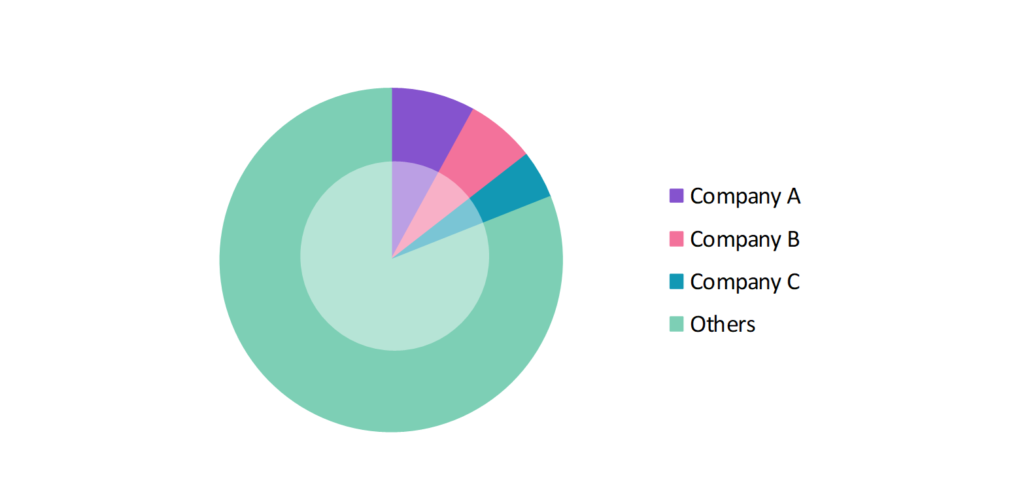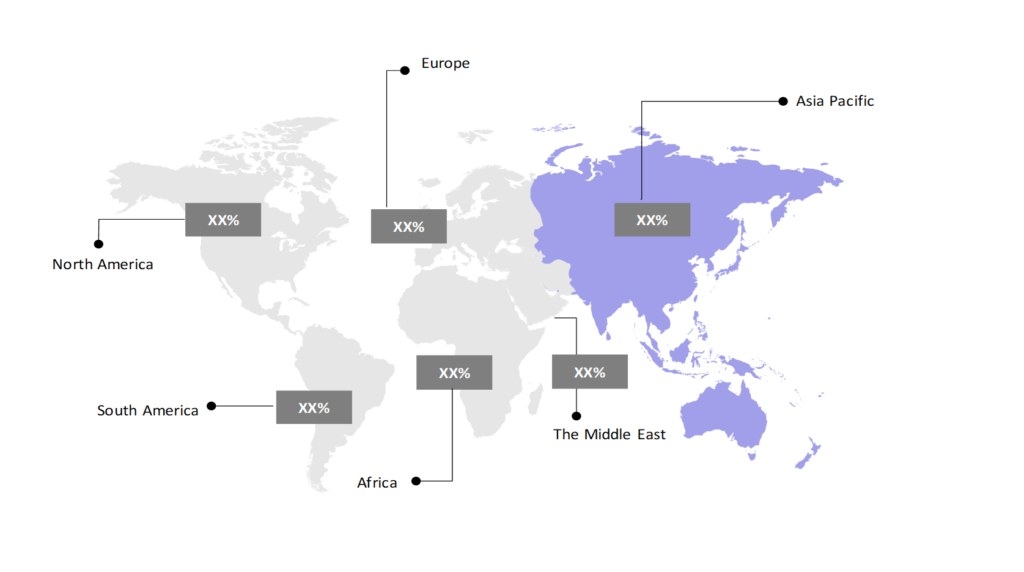Toys And Games Market Insights: Size, Share, Growth Analysis & Forecast (2024-2029)
The market report provided a comprehensive analysis segmented by Product (Puzzles, Preschool Toys, Outdoor and Sports, Dolls, Video Games, Others); by Distribution Channel (Offline, Online); by Geography (North America, South America, Asia Pacific, Europe, The Middle East, Africa).
Outlook

- The toys and games market is estimated to be at USD 351.19 Bn in 2025 and is anticipated to reach USD 458.11 Bn in 2030.
- The toys and games market is registering a CAGR of 5.46% during the forecast period 2025-2030.
- The global toy and game market has witnessed steady growth, driven by an expanding target demographic, including children and adults, and an increased disposable income. The rise of digital and educational toys and the popularity of licensed products from film and television franchises continue to shape the market landscape.
Request a free sample.
Ecosystem

- The global toys and games industry participants are continuously developing strategies to preserve a competitive advantage.
- These companies primarily use acquisitions, research & developments, partnerships, and technological launches.
- Several important entities in the toys and games market include LEGO Group; Hasbro, Inc.; Mattel, Inc.; VTech Holdings Ltd.; Konami Group Corp.; and others.
Ask for customization.
Findings
| Attributes | Values |
|---|---|
| Historical Period | 2019-2023 |
| Base Year | 2024 |
| Forecast Period | 2025-2030 |
| Market Size (2025) | USD 351.19 Bn |
| Market Size (2030) | USD 458.11 Bn |
| Growth Rate | 5.46% CAGR from 2025 to 2030 |
| Key Segments | Product (Puzzles, Preschool Toys, Outdoor and Sports, Dolls, Video Games, Others); Distribution Channel (Offline, Online); Geography (North America, South America, Asia Pacific, Europe, The Middle East, Africa) |
| Key Vendors | LEGO Group; Hasbro, Inc.; Mattel, Inc.; VTech Holdings Ltd.; Konami Group Corp. |
| Key Countries | The US; Canada; Mexico; Brazil; Argentina; Colombia; China; India; Japan; Vietnam; Indonesia; The UK; Germany; France; UAE; Saudi Arabia; Egypt; South Africa |
| Largest Market | Asia Pacific |
Get a free quote.
Trends
- Technological Integration and STEM Toys: The integration of technology into toys, including AI (artificial intelligence), robotics, and augmented reality (AR), continues to gain emphasis. With products like Osmo and LEGO Mindstorms, the shift toward educational toys that promote science, technology, engineering, and math (STEM) skills has emerged.
- Sustainability in Toy Manufacturing: Rising awareness of environmental issues has prompted toy manufacturers to adopt more sustainable practices and materials. Companies such as LEGO have pledged to use eco-friendly materials to produce fully recyclable and biodegradable products by 2030. In 2023, Mattel introduced a new line of toys made from recycled plastic, reflecting the industry’s broader shift toward more environmentally responsible production.
- Digital Gaming Convergence: Traditional toys are increasingly integrated with digital components to enhance play. Hybrid toys that connect with apps and games, such as Tamagotchi Pix and Pokémon Go Plus, bridge the gap between physical and digital play, appealing to tech-savvy consumers. Augmented reality gaming is expected to shift alongside the toy sector as more interactive products are introduced.
Speak to analyst.
Catalysts
- Increasing Disposable Incomes: As global disposable incomes increase, parents spend more on toys and games for their children, driving higher market demand. This has led to a growing preference for high-quality, educational, and interactive toys that foster children’s cognitive, emotional, and social development. Consequently, the market for developmentally beneficial toys is expanding, fueled by greater consumer spending power and a shift toward more purposeful and enriching play experiences.
- Expansion of Licensed and Franchise Products: The toys and games market thrives on products tied to popular franchises such as Marvel, Star Wars, and Disney properties. The release of major blockbuster films and TV shows significantly boosted the sales of licensed toys. For instance, “Barbie” movie merchandise saw a sharp increase in market growth following the film’s release in July 2023.
- Rise of Collectible and Adult-Oriented Toys: The adult collectibles and toy market, particularly the “kidult” segment, has grown significantly, driven by nostalgia and a desire for more sophisticated play experiences. In 2023, products like Funko Pop! figures, adult-themed LEGO sets, and complex board games gained popularity among adults seeking entertainment and a connection to their childhood. This growth highlights the increasing appeal of toys and collectibles for adults, focusing on nostalgia, creativity, and exclusivity.
Inquire before buying.
Restraints
- Regulatory Compliance and Safety Standards: Strict toy safety regulations pose challenges for manufacturers. The EU Toy Safety Directive and other global standards require compliance with rigorous chemical and mechanical testing, which can increase production costs. Recall of toys containing hazardous substances highlighted the challenge of stricter adherence to safety protocols, restraining the growth of the toys and games market.
- Fluctuating Raw Material Prices: The volatility in raw material costs, such as plastics and electronic components, impacts profit margins. The post-pandemic period has seen supply chain disruptions and price hikes, causing many toy companies to reassess pricing strategies and production schedules and posing challenges for the market.
- Counterfeit Products and Brand Imitations: The prevalence of counterfeit toys and brand imitations remains a significant issue, especially in developing regions. These products often do not meet safety standards, undermine brand integrity, and pose risks to consumers. Several toy and game providers took legal action against counterfeit manufacturers, but the issue remains a significant market challenge.
Personalize this research.
Hotspot

Explore purchase options.
Table of Contents
| 1. Introduction 1.1. Research Methodology 1.2. Scope of the Study 2. Market Overview / Executive Summary 2.1. Global Toys and Games Market (2019 – 2023) 2.2. Global Toys and Games Market (2024 – 2030) 3. Market Segmentation 3.1. Global Toys and Games Market by Product 3.1.1. Puzzles 3.1.2. Preschool Toys 3.1.3. Outdoor and Sports 3.1.4. Dolls 3.1.5. Video Games 3.1.6. Others 3.2. Global Toys and Games Market by Distribution Channel 3.2.1. Offline 3.2.2. Online 4. Regional Segmentation 4.1. North America 4.1.1. The US 4.1.2. Canada 4.1.3. Mexico 4.2. South America 4.2.1. Brazil 4.2.2. Argentina 4.2.3. Colombia 4.2.4. Rest of South America 4.3. Asia Pacific 4.3.1. China 4.3.2. India 4.3.3. Japan 4.3.4. Vietnam 4.3.5. Indonesia 4.3.6. Rest of Asia Pacific 4.4. Europe 4.4.1. The UK 4.4.2. Germany 4.4.3. France 4.4.4. Rest of Europe 4.5. The Middle East 4.5.1. UAE 4.5.2. Saudi Arabia 4.5.3. Rest of the Middle East 4.6. Africa 4.6.1. Egypt 4.6.2. South Africa 4.6.3. Rest of Africa 5. Value Chain Analysis of the Global Toys and Games Market 6. Porter Five Forces Analysis 6.1. Threats of New Entrants 6.2. Threats of Substitutes 6.3. Bargaining Power of Buyers 6.4. Bargaining Power of Suppliers 6.5. Competition in the Industry 7. Trends, Drivers and Challenges Analysis 7.1. Market Trends 7.1.1. Market Trend 1 7.1.2. Market Trend 2 7.1.3. Market Trend 3 7.2. Market Drivers 7.2.1. Market Driver 1 7.2.2. Market Driver 2 7.2.3. Market Driver 3 7.3. Market Challenges 7.3.1. Market Challenge 1 7.3.2. Market Challenge 2 7.3.3. Market Challenge 3 8. Opportunities Analysis 8.1. Market Opportunity 1 8.2. Market Opportunity 2 8.3. Market Opportunity 3 9. Competitive Landscape 9.1. LEGO Group 9.2. Hasbro, Inc. 9.3. Mattel, Inc. 9.4. VTech Holdings Ltd. 9.5. Konami Group Corp. 9.6. Company 6 9.7. Company 7 9.8. Company 8 9.9. Company 9 9.10. Company 10 |
Know the research methodology.
Toys and Games Market – FAQs
1. What is the current size of the toys and games market?
Ans. In 2025, the toys and games market size is USD 351.19 Bn.
2. Who are the major vendors in the toys and games market?
Ans. The major vendors in the toys and games market are LEGO Group; Hasbro, Inc.; Mattel, Inc.; VTech Holdings Ltd.; Konami Group Corp.
3. Which segments are covered under the toys and games market segments analysis?
Ans. The toys and games market report offer in-depth insights into Product, Distribution Channel, and Geography.
